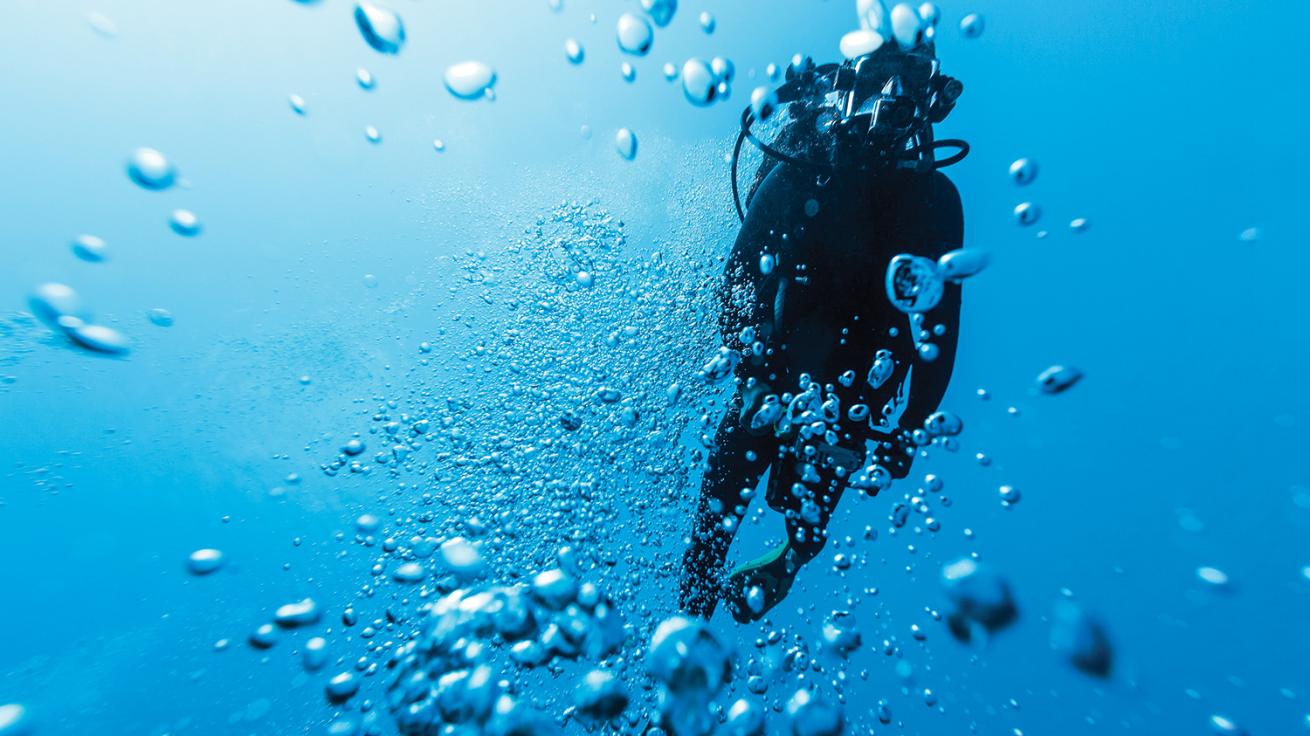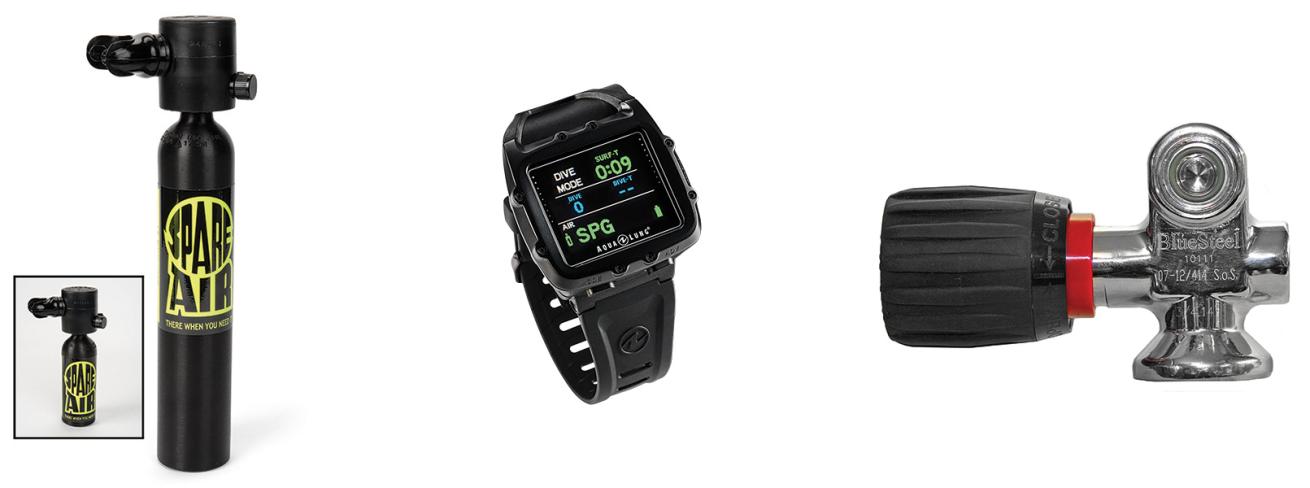How to Avoid Out-of-Air Emergencies while Scuba Diving

MaFelipe/iStockHere are our tips for scuba divers on how to avoid out-of-air emergencies and what to do if you run out of air.
Running out of air underwater is a diver’s worst nightmare. You draw on your second stage, expecting that sweet, lung-satisfying sip of air — and get nothing. It’s a terrifying emergency that none of us should have to experience. However, according to Divers Alert Network, one of the world’s foremost centers for research on underwater emergencies and injuries, running out of breathing gas is the most common dive incident, and the No. 1 cause of diving fatalities.
The sources of out-of-air emergencies are numerous and varied. Common complacency or too much task-loading can distract a diver from monitoring his or her gas supply until it reaches a dangerously low level. Malfunctioning equipment, such as regulators, hoses and O-rings, can create disastrous complications at depth. Tests have shown that a free-flowing regulator or ruptured hose can drain an 80-cubic-inch cylinder in less than three minutes, depending on depth. Typically, divers have precious little time to deal with this situation before it turns dire. All too often, they become a statistic.
“At least once a year I see somebody run out of air underwater,” says Becky Kagan Schott, a Pennsylvania-based technical and CCR instructor, cave enthusiast, and Emmy Award-winning underwater cinematographer. “No matter what type of dive you’re attempting, whether it is recreational or technical, and no matter what your experience or level of certification, it can happen to anyone.”
Fortunately, many of these accidents can be prevented. Through advanced training, regular equipment maintenance and mindful discipline, divers can increase their odds of avoiding — and surviving — an out-of-air emergency.
“My grandfather used to tell me the best way to deal with a problem is to not have it in the first place,” says Edd Sorenson of Cave Adventurers in Marianna, Florida, a technical and rebreather instructor who also is a highly experienced cave search-and-rescue expert. “At first that sounded really stupid, but now I use it in every one of my classes.”
Consider this expert advice to minimize your risk of running out of air underwater.
Pay close attention
Out-of-air emergencies can occur due to simple negligence. Skipping a predive buddy check, ignoring obvious equipment issues or forgetting to turn on your air before you drop can all lead to disaster. Schott and Sorenson preach situational awareness.
“You see too many times people getting into currents, diving a little deeper than they’re used to, or being distracted with a camera and getting in trouble,” Schott says. “One of the biggest things I reinforce with my students is being self-aware, and always watching your gauges.”
When divers suffer a lack of situational awareness and something bad happens, stress can escalate quickly — and turn deadly.
“When you’re under stress, you can experience what’s called cognitive narrowing — you don’t have that big-picture thinking anymore,” Sorenson says. “We had an incident in a cave where the diver had three functioning regulators and three cylinders filled with more than 300 cubic feet of gas, but his brain told him he was out of gas. With cognitive narrowing, he just panicked and attacked his buddy.”
Being mindful of your surroundings and situation can save lives — especially yours.
Learn to deal
As divers, we train to deal with common emergencies. But too often, we let those skills grow rusty. By practicing the protocols you’ve learned to manage out-of-air emergencies, you’ll be far better prepared if it happens to you.
“Instead of reacting, many divers tend to freeze or panic,” Schott says. “Those situations could be avoided if people practiced skills more often. It’s a great idea to go out with your dive buddy and do emergency drills so you can react faster.”
“Most divers probably haven’t practiced air-sharing techniques since they finished their open-water class,” Sorenson says. “Nobody wants to go out and do a work dive, but there’s always that three-minute safety stop to practice. You’ve got to be there anyway, why not do something that could one day help save your life or that of your friend?”
Sorenson also advises never to skip a predive buddy check, and focus particular attention on pre-breathing all of your air sources. In addition, learning hand signals that identify potential air-supply hazards is a smart prevention method.
“For cave diving, we have an entire set of hand signals” to identify potential gas emergencies, he says. “One of them is placing your index finger above your thumb and lightly moving up and down to indicate to your buddy that they have bubbles coming out of a hose or other piece of equipment. If something on my setup is bubbling that I can’t see but you can, that’s something I need to know.”

Courtesy of manufacturers
Spare Air Aqua Lung I750TC Vindicator Scuba Tank Valve Safety Handle $320 ($340 for nitrox); spareair.com $999; aqualung.com $15.89; vindicator-safety- handle.myshopify.com For emergency bailouts, this compact bottle-and-regulator combo can provide enough gas to get to the surface from a shallow depth. It’s available in 1.7 and 3 cubic feet, is nitrox-capable, and can be filled from a primary cylinder. Air-integrated computers serve up tank-pressure info in a quick and convenient display. The i750TC boasts a full-color OLED screen and Bluetooth smart wireless connectivity for tank-transmitter pairing and mobile-device sharing. This smart valve-handle replacement uses a simple red-for-closed, green-for-open indicator system that takes the guesswork out of your air supply. It’s made from durable materials and is designed to fit a wide range of valves.
Double down on redundancy
For technical divers, redundant systems are fundamental. If an air source malfunctions, having a backup will save your life. Recreational divers should consider this safety net as well.
“Carrying a pony bottle just for emergencies, especially on deeper dives, can be a really good option,” Schott says. “Having more gas in case you have a problem and aren’t close enough to your buddy can really make a difference in an out-of-air emergency.”
For divers considering adding an alternate air supply to their kit, Schott recommends at least a 19-cubic-foot cylinder that can be strapped to a primary tank, with the second stage arranged around the neck on a necklace.
“Diving twin cylinders or learning to dive sidemount offers a lot of advantages for your safety,” says Sorenson. “Diving an air-integrated computer is nice, to have that pressure data right there on your wrist, but divers should also have an analog pressure gauge as a backup.”
Know your SAC rate
Beyond equipment issues, some out-of-air emergencies are just that — the diver simply used all of his gas supply before the end of the dive. Poor planning is typically the cause, so learning to calculate your surface air consumption (SAC) rate — and using it to plan your dives — can help prevent dangerous mistakes.
“I really encourage people to learn how to calculate their SAC rate so they can figure out how much air they’re going to need to do a certain dive, while allowing for unexpected challenges that might force them to use more gas than normal,” Schott says. “You might be surprised that what an 80-cubic-foot cylinder holds is just not enough gas.”
“Everybody should know how to calculate their SAC rate because if you’re diving in the ocean, there can be currents and other factors that will affect the amount of gas you’re consuming,” Sorenson says. “If you do it properly, it’s a simple calculation. I teach it to all my cave students, and I have them do it on each and every dive. It builds self-confidence and makes for safer diving.”
Calculating your consumption
To increase the precision of your dive plan, learn to figure out how many cubic feet of air per minute you typically consume.
Establish a base consumption figure with a test run of 33 feet for 10 minutes (five minutes out and five minutes back) at your normal dive pace. Then plug your data into this equation:
SAC = (1-P2/P1) x Vf/Aa/Tm
P1 = pressure in psi at beginning of test dive
P2 = pressure in psi at end of test dive
Vf = volume of air in cylinder in cubic feet (divide the actual pressure by the full pressure, and multiply by the volume in cubic feet of a full tank)
Aa = pressure in absolute atmospheres
Tm = time of dive in minutes
Want more explanation? Visit here.










